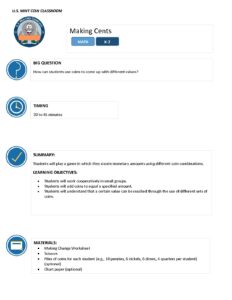Summary
Objectives
- Students will work cooperatively in small groups.
- Students will add coins to equal a specified amount.
- Students will understand that a certain value can be reached through the use of different sets of coins.
Subject Area
- Math
Grades
- K
- 1st
- 2nd
Class Time
- Total Time: 0-45 Minutes minutes
Materials
- Making Change Worksheet
- Scissors
- Piles of coins for each student (e.g., 10 pennies, 6 nickels, 6 dimes, 4 quarters per student) (optional)
- Chart paper (optional)
Lesson Steps
1. Start the lesson by reviewing what coins are and how we use them. Ask students to share when they may have seen or used coins.
2. Explain that when we use coins, we usually combine coins together to make a specific amount of money. For example, we might use two quarters to buy a piece of candy that costs 50 cents.
3. Pass out the Making Cents Worksheet and explain that the class is going to count the coins on the sheet together.
4. Count how many of each coin are on the worksheet together as a class and write the answers on the worksheet.
5. Now divide the class into groups of 3 students.
6. If you are using paper coins, ask students to cut out the coins on the worksheet and put their coins in a pile.
7. If you have real coins to provide, pass these out to each student.
8. Assign one group member to each role of counter, checker, or announcer for Round 1. These roles will change each round.
Play Making Cents (20 minutes)9. Explain the game instructions to your students.
-
- The game begins when you write a coin amount for all the students to see. You then select coins out of the "teacher's pile" that equal the displayed amount, but keep them covered.
- Each group has one minute to find a way to represent the coin amount using only the coins in the pile. After the minute is over, the announcer from each group reports back to the class what coin combination was used to reach the displayed amount.
- Use an online timer or set a timer on your phone/computer to keep time and alert students to when one minute is up.
- Each group gets one point for being accurate with its coin combination. After you reveal the combination you used, an additional point goes to those groups whose choice of coins matched yours.
10. Sample amounts to use for the coin groupings on the Making Change Worksheet:
-
- Round 1: 50 cents
- Round 2: 28 cents
- Round 3: 35 cents
- Round 4: 74 cents
- Round 5: 13 cents
11. Play as many rounds as you like
Differentiated Learning Options
- To extend this game for more advanced learners, invite the students to create multiple coin combinations for the same amount. Award an additional point for each additional coin combination a student develops.
- If students are struggling, start with easy to work with numbers (e.g., multiples of 5, numbers under 20) and increase with difficulty each round.
- Give students 2 minutes for the first few rounds and gradually reduce the time as they get more comfortable with the game.
- Display the coin values in a prominent place so students can reference it as they play.

